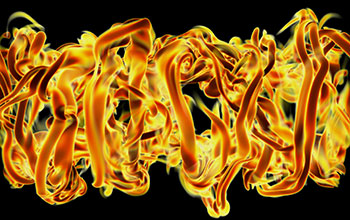Multimedia Gallery
3D reconstruction of the collision dynamics of two vortices
Researchers may have identified a fundamental mechanism by which turbulence develops by smashing vortex rings head-on into each other, recording the results with ultra-high-resolution cameras and reconstructing the collision dynamics using a 3D visualization program. Here we see a 3D reconstruction of the collision dynamics of two vortices.
[Research supported by National Science Foundation grants DMR 1420570, DMS 1411694 and DMS 1715477.]
Learn more in the Harvard SEAS news story Unraveling turbulence:
New insights into how fluids transform from order to disorder. (Date image taken: unknown; date originally posted to NSF Multimedia Gallery: July 18, 2020)
Credit: Image courtesy of Ryan McKeown/Harvard SEAS
Images and other media in the National Science Foundation Multimedia Gallery are available for use in print and electronic material by NSF employees, members of the media, university staff, teachers and the general public. All media in the gallery are intended for personal, educational and nonprofit/non-commercial use only.
Images credited to the National Science Foundation, a federal agency, are in the public domain. The images were created by employees of the United States Government as part of their official duties or prepared by contractors as "works for hire" for NSF. You may freely use NSF-credited images and, at your discretion, credit NSF with a "Courtesy: National Science Foundation" notation.
Additional information about general usage can be found in Conditions.
Also Available:
Download the high-resolution JPG version of the image. (1.0 MB)
Use your mouse to right-click (Mac users may need to Ctrl-click) the link above and choose the option that will save the file or target to your computer.



 All images in this series
All images in this series